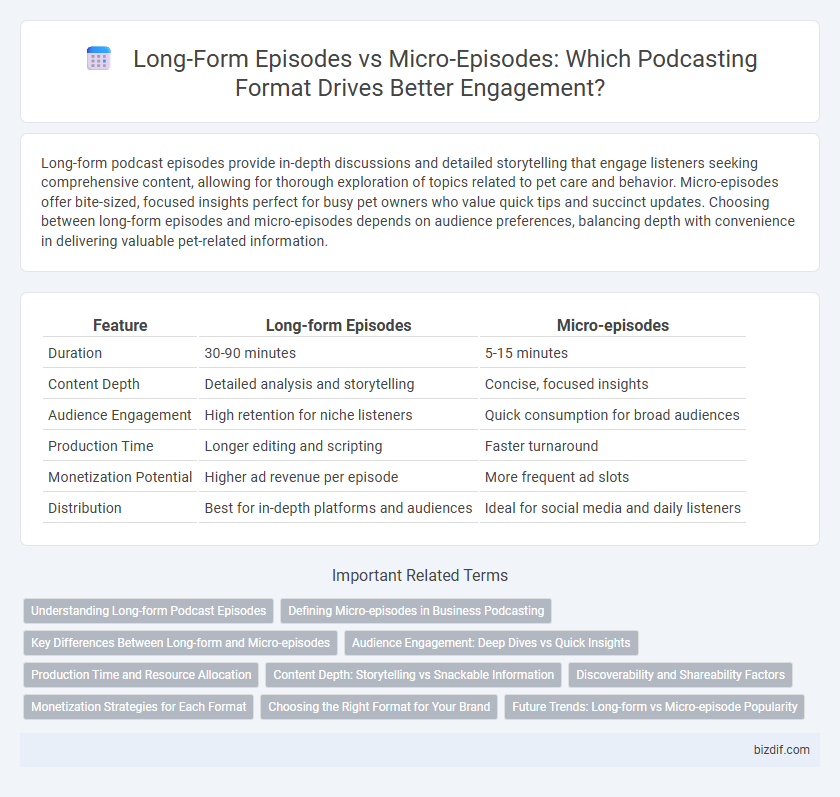Long-form podcast episodes provide in-depth discussions and detailed storytelling that engage listeners seeking comprehensive content, allowing for thorough exploration of topics related to pet care and behavior. Micro-episodes offer bite-sized, focused insights perfect for busy pet owners who value quick tips and succinct updates. Choosing between long-form episodes and micro-episodes depends on audience preferences, balancing depth with convenience in delivering valuable pet-related information.
Table of Comparison
| Feature | Long-form Episodes | Micro-episodes |
|---|---|---|
| Duration | 30-90 minutes | 5-15 minutes |
| Content Depth | Detailed analysis and storytelling | Concise, focused insights |
| Audience Engagement | High retention for niche listeners | Quick consumption for broad audiences |
| Production Time | Longer editing and scripting | Faster turnaround |
| Monetization Potential | Higher ad revenue per episode | More frequent ad slots |
| Distribution | Best for in-depth platforms and audiences | Ideal for social media and daily listeners |
Understanding Long-form Podcast Episodes
Long-form podcast episodes, typically ranging from 30 minutes to over two hours, allow for deep dives into complex topics, providing comprehensive insights and detailed storytelling. These episodes often feature expert interviews, extensive discussions, and narrative-driven content that enhances listener engagement and retention. Long-form formats cater to audiences seeking in-depth knowledge and a more immersive podcast experience.
Defining Micro-episodes in Business Podcasting
Micro-episodes in business podcasting are concise, focused audio segments typically lasting between 5 to 15 minutes, designed to deliver high-impact insights quickly. These episodes prioritize clarity and brevity, enabling busy professionals to consume valuable content during short breaks or commutes. By offering targeted discussions on specific topics or actionable tips, micro-episodes enhance listener engagement and retention without overwhelming the audience.
Key Differences Between Long-form and Micro-episodes
Long-form podcast episodes typically exceed 30 minutes, allowing for in-depth discussions, detailed storytelling, and comprehensive interviews, which attract listeners seeking immersive content. Micro-episodes usually last under 10 minutes, delivering concise, focused insights or quick updates ideal for busy audiences with limited listening time. The choice between long-form and micro-episodes impacts engagement, content depth, and audience retention based on listener preferences and consumption habits.
Audience Engagement: Deep Dives vs Quick Insights
Long-form podcast episodes deliver in-depth analysis and comprehensive storytelling that fosters strong audience engagement through deep dives into complex topics. Micro-episodes provide quick insights and timely information, appealing to listeners seeking brief, easily digestible content during short breaks. Balancing long-form content with micro-episodes can optimize audience retention by catering to diverse listening preferences and engagement levels.
Production Time and Resource Allocation
Long-form podcast episodes typically require extensive production time, including detailed scripting, thorough editing, and higher resource allocation for sound quality and guest coordination. Micro-episodes demand less time and fewer resources, allowing for quicker turnaround and more frequent publishing schedules. Efficient resource management depends on the podcast's goals, with long-form content enhancing depth and micro-episodes supporting consistent audience engagement.
Content Depth: Storytelling vs Snackable Information
Long-form podcast episodes provide in-depth storytelling and comprehensive exploration of topics, allowing hosts to develop nuanced narratives and foster deep listener engagement. In contrast, micro-episodes deliver quick, snackable information ideal for audiences seeking concise insights or updates, maximizing retention in shorter time frames. Tailoring episode length to content depth enhances audience satisfaction by aligning story complexity with listener preferences.
Discoverability and Shareability Factors
Long-form podcast episodes typically offer in-depth content that enhances discoverability through detailed show notes and episode transcriptions, improving SEO rankings on platforms like Spotify and Apple Podcasts. Micro-episodes boost shareability by providing concise, easily digestible content ideal for social media sharing and quick listener engagement on apps such as Instagram and Twitter. Balancing long-form depth with micro-episode accessibility can optimize podcast reach and audience growth.
Monetization Strategies for Each Format
Long-form podcast episodes generate higher listener retention and more extensive ad slots, attracting premium advertisers willing to pay for deep engagement and brand integration. Micro-episodes excel in frequent publishing and viral potential, allowing monetization through sponsorships, dynamic ad insertions, and listener donations on platforms like Patreon. Tailoring monetization strategies to episode length optimizes revenue by capitalizing on audience behavior and advertiser preferences.
Choosing the Right Format for Your Brand
Long-form podcast episodes, typically lasting 30 to 60 minutes, enable in-depth storytelling and detailed discussions, fostering stronger listener engagement and brand loyalty. Micro-episodes, often under 10 minutes, cater to audiences seeking quick, digestible content, ideal for brands targeting busy listeners or promoting concise messages. Selecting the right format depends on your brand's goals, audience preferences, and content strategy to maximize reach and impact.
Future Trends: Long-form vs Micro-episode Popularity
Long-form podcast episodes continue to attract dedicated listeners seeking in-depth discussions, while micro-episodes gain traction for their convenience and shareability on social media platforms. Industry data predicts a growing hybrid model where podcasts integrate both formats to cater to diverse audience preferences and increase engagement. Emerging AI tools automate episode segmentation, facilitating easier consumption and personalized content delivery in future podcast trends.
Long-form Episodes vs Micro-episodes Infographic

 bizdif.com
bizdif.com